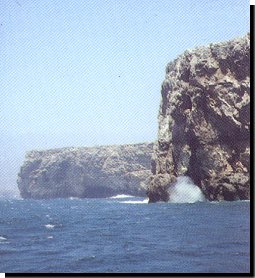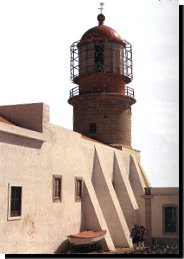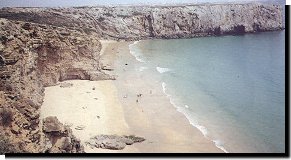Around and About
 The mystique and the physical grandeur of Sagres and Cape St Vincent
attract great numbers of daytrippers. Those who choose to stay a few days or even weeks,
can do so in style at the Pousada Infante, the Hotel Baleeira,
the Navigator Hotel Apartments, or at all sorts of
lesser accommodation down to cheap, private rooms and a friendly camp site.
The mystique and the physical grandeur of Sagres and Cape St Vincent
attract great numbers of daytrippers. Those who choose to stay a few days or even weeks,
can do so in style at the Pousada Infante, the Hotel Baleeira,
the Navigator Hotel Apartments, or at all sorts of
lesser accommodation down to cheap, private rooms and a friendly camp site.
Those who arrive to stay a while are usually glad to
be at the end of the line, on the outer fringe of Algarve tourism, away from the glitz of
the commercial south coast. A great many arrive with packs on their backs and with
Australian, New Zealand, North American, or South African accents. The square in front of
the CaTh' Conchina is the main meeting place for backpackers by day. It is the point of
arrival and departure for buses, the junction between boarding house and beach, a place to
linger and meet new friends over coffee or beer. In the evening, the scene shifts slightly
to inexpensive restaurants and watering holes with names like Quatros dos Ventos and the
Last Chance.
On Ponta de Sagres, a giant finger of rock pointing
to the ocean, stand buildings which evoke the past of a place that is part of the history
of the world. The fortress is situated here, dating back to the 15th century, and the
church of Nossa Senhora da Graça, which tradition says was founded by Prince Henry the
Navigator.
 Cabo de São
Vicente ( Cape St. Vincent ) is an obligatory landmark to any ship travelling to the
Mediterranean. Here many major sea battles were fought just in front of its fortress. The
Cape takes its name from a Spanish priest martyred at the beginning of the 4th
century. According to legend, his remains were brought or washed ashore on Promontorium
Sacrum, the Sacred Cape, as it was known in ancient times.Inside
the fortress a chapel can be found, built on what is traditionally said to be the site of
St. Vincent's grave.
Cabo de São
Vicente ( Cape St. Vincent ) is an obligatory landmark to any ship travelling to the
Mediterranean. Here many major sea battles were fought just in front of its fortress. The
Cape takes its name from a Spanish priest martyred at the beginning of the 4th
century. According to legend, his remains were brought or washed ashore on Promontorium
Sacrum, the Sacred Cape, as it was known in ancient times.Inside
the fortress a chapel can be found, built on what is traditionally said to be the site of
St. Vincent's grave.  The original temple, perhaps on the site of
the Forte de Beliche, was watched over by 10 ravens which never left it. During the reign
of Afonso Henriques (1139 - 85 ), Vincent's remains were exhumed and taken by ship for
reburial in Lisbon to protect them from desecration by the Muslims. Legend has it that the
raven kept constant vigil from the rigging of the ship all the way. Because of this, the
raven is still part of the insignia of both the city of Lisbon and of Cape St Vincent's
local seat of administration, Vila do Bispo.
The original temple, perhaps on the site of
the Forte de Beliche, was watched over by 10 ravens which never left it. During the reign
of Afonso Henriques (1139 - 85 ), Vincent's remains were exhumed and taken by ship for
reburial in Lisbon to protect them from desecration by the Muslims. Legend has it that the
raven kept constant vigil from the rigging of the ship all the way. Because of this, the
raven is still part of the insignia of both the city of Lisbon and of Cape St Vincent's
local seat of administration, Vila do Bispo.
Cape St Vincent lighthouse was built on the site of a
16th-century Franciscan convent in 1846. It was electrified in 1906, and is situated at
the end of the 6 km road from Sagres. The two 1,000-watt lamps magnified by concentric
rows of prisms throw a 10 foot tall beam 60 km out to sea making it the second most
powerful lighthouse in Europe. It keeps vigil over one of the world's busiest shipping
lanes. All shipping from and through the Mediterranean to the west coast of Europe and
most of the eastern seaboard of North America passes this way.
 Baleeira is a
small picturesque fishing port of Sagres, which houses up to one hundred fishing boats,
some over 20 metres in length. There are four good beaches in the
neighbourhood. Praia do Martinhal is the farthest from the village, but it is the biggest
and the most protected if a westerly wind is blowing. It stretches from the Baleeira
fishing harbour to an outcrop of low cliffs, the site of a Roman settlement which
specialised in the production of amphorae. Praia da Mareta just below the village and
facing south-east is tucked in the lee of Sagres Point. Over on the other side and facing
west is Tonel, a small beach with steep access. There is a long beach at Beliche, perhaps
the best around Sagres.
Baleeira is a
small picturesque fishing port of Sagres, which houses up to one hundred fishing boats,
some over 20 metres in length. There are four good beaches in the
neighbourhood. Praia do Martinhal is the farthest from the village, but it is the biggest
and the most protected if a westerly wind is blowing. It stretches from the Baleeira
fishing harbour to an outcrop of low cliffs, the site of a Roman settlement which
specialised in the production of amphorae. Praia da Mareta just below the village and
facing south-east is tucked in the lee of Sagres Point. Over on the other side and facing
west is Tonel, a small beach with steep access. There is a long beach at Beliche, perhaps
the best around Sagres.
 The beaches up the west coast are
fantastic, many of them comprising of acres of nearly deserted sand backed by dunes or
cliffs looking out over lines of surf cascading in on the wildly beautiful shore. Among
the most breathtaking are the ones on either side of a track which runs along the
clifftops adjacent to the old village of Carrapateira, 14km north of Vila do Bispo. Apart
from a couple of beach bars, the coastline here is total natural.
The beaches up the west coast are
fantastic, many of them comprising of acres of nearly deserted sand backed by dunes or
cliffs looking out over lines of surf cascading in on the wildly beautiful shore. Among
the most breathtaking are the ones on either side of a track which runs along the
clifftops adjacent to the old village of Carrapateira, 14km north of Vila do Bispo. Apart
from a couple of beach bars, the coastline here is total natural.
 The mystique and the physical grandeur of Sagres and Cape St Vincent
attract great numbers of daytrippers. Those who choose to stay a few days or even weeks,
can do so in style at the Pousada Infante, the Hotel Baleeira,
the Navigator Hotel Apartments, or at all sorts of
lesser accommodation down to cheap, private rooms and a friendly camp site.
The mystique and the physical grandeur of Sagres and Cape St Vincent
attract great numbers of daytrippers. Those who choose to stay a few days or even weeks,
can do so in style at the Pousada Infante, the Hotel Baleeira,
the Navigator Hotel Apartments, or at all sorts of
lesser accommodation down to cheap, private rooms and a friendly camp site. Cabo de São
Vicente ( Cape St. Vincent ) is an obligatory landmark to any ship travelling to the
Mediterranean. Here many major sea battles were fought just in front of its fortress. The
Cape takes its name from a Spanish priest martyred at the beginning of the 4th
century. According to legend, his remains were brought or washed ashore on Promontorium
Sacrum, the Sacred Cape, as it was known in ancient times.Inside
the fortress a chapel can be found, built on what is traditionally said to be the site of
St. Vincent's grave.
Cabo de São
Vicente ( Cape St. Vincent ) is an obligatory landmark to any ship travelling to the
Mediterranean. Here many major sea battles were fought just in front of its fortress. The
Cape takes its name from a Spanish priest martyred at the beginning of the 4th
century. According to legend, his remains were brought or washed ashore on Promontorium
Sacrum, the Sacred Cape, as it was known in ancient times.Inside
the fortress a chapel can be found, built on what is traditionally said to be the site of
St. Vincent's grave.  The original temple, perhaps on the site of
the Forte de Beliche, was watched over by 10 ravens which never left it. During the reign
of Afonso Henriques (1139 - 85 ), Vincent's remains were exhumed and taken by ship for
reburial in Lisbon to protect them from desecration by the Muslims. Legend has it that the
raven kept constant vigil from the rigging of the ship all the way. Because of this, the
raven is still part of the insignia of both the city of Lisbon and of Cape St Vincent's
local seat of administration, Vila do Bispo.
The original temple, perhaps on the site of
the Forte de Beliche, was watched over by 10 ravens which never left it. During the reign
of Afonso Henriques (1139 - 85 ), Vincent's remains were exhumed and taken by ship for
reburial in Lisbon to protect them from desecration by the Muslims. Legend has it that the
raven kept constant vigil from the rigging of the ship all the way. Because of this, the
raven is still part of the insignia of both the city of Lisbon and of Cape St Vincent's
local seat of administration, Vila do Bispo. Baleeira is a
small picturesque fishing port of Sagres, which houses up to one hundred fishing boats,
some over 20 metres in length. There are four good beaches in the
neighbourhood. Praia do Martinhal is the farthest from the village, but it is the biggest
and the most protected if a westerly wind is blowing. It stretches from the Baleeira
fishing harbour to an outcrop of low cliffs, the site of a Roman settlement which
specialised in the production of amphorae. Praia da Mareta just below the village and
facing south-east is tucked in the lee of Sagres Point. Over on the other side and facing
west is Tonel, a small beach with steep access. There is a long beach at Beliche, perhaps
the best around Sagres.
Baleeira is a
small picturesque fishing port of Sagres, which houses up to one hundred fishing boats,
some over 20 metres in length. There are four good beaches in the
neighbourhood. Praia do Martinhal is the farthest from the village, but it is the biggest
and the most protected if a westerly wind is blowing. It stretches from the Baleeira
fishing harbour to an outcrop of low cliffs, the site of a Roman settlement which
specialised in the production of amphorae. Praia da Mareta just below the village and
facing south-east is tucked in the lee of Sagres Point. Over on the other side and facing
west is Tonel, a small beach with steep access. There is a long beach at Beliche, perhaps
the best around Sagres. The beaches up the west coast are
fantastic, many of them comprising of acres of nearly deserted sand backed by dunes or
cliffs looking out over lines of surf cascading in on the wildly beautiful shore. Among
the most breathtaking are the ones on either side of a track which runs along the
clifftops adjacent to the old village of Carrapateira, 14km north of Vila do Bispo. Apart
from a couple of beach bars, the coastline here is total natural.
The beaches up the west coast are
fantastic, many of them comprising of acres of nearly deserted sand backed by dunes or
cliffs looking out over lines of surf cascading in on the wildly beautiful shore. Among
the most breathtaking are the ones on either side of a track which runs along the
clifftops adjacent to the old village of Carrapateira, 14km north of Vila do Bispo. Apart
from a couple of beach bars, the coastline here is total natural. 


